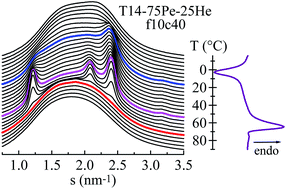Dependence of phase transitions on composition in isotactic poly(propylene-co-1-pentene-co-1-hexene) terpolymers
Abstract
Different crystalline lattices are found to be developed in isotactic poly(propylene-co-1-pentene-co-1-hexene) terpolymers (synthesized by using a metallocene catalytic system) depending on: (a) overall content in comonomers, (b) 1-pentene/1-hexene ratio, and (c) crystallization and recrystallization conditions. The various polymorphs (monoclinic, orthorhombic, mesomorphic and trigonal crystallites) can be either the unique crystalline form present in the resulting terpolymer specimen or can coexist with other crystalline lattices. The knowledge of the experimental conditions for obtaining a certain modification or for its transformation into another ordered phase is of a significant relevance because of the importance for tuning final structures, seeking particular properties. The evaluation of these fundamental variables is carried out here by differential scanning calorimetry using broad ranges of cooling rates and subsequent heating. A clear assignment of the crystalline polymorphs is performed by X-ray diffraction using either conventional or synchrotron radiation.


 Please wait while we load your content...
Please wait while we load your content...